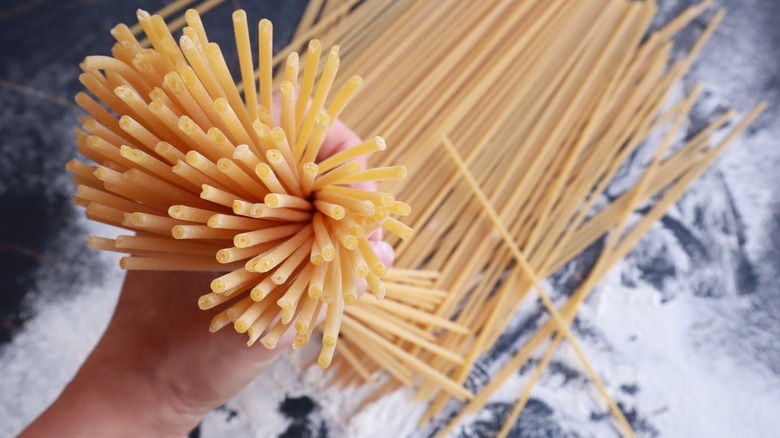The Crucial Tips You Need For Restaurant-Worthy Bucatini Pasta
If you're still working on memorizing your pasta shapes, bucatini is perhaps a less common but no less appetizing pasta. Bucatini noodles are long enough that they resemble spaghetti, but they've also got holes running through their center like penne or macaroni. It may not seem like much, but that hole does change how you should prepare the pasta, and there are specific strategies for perfecting a bucatini dish.
Chowhound exclusively spoke with Chef Jasper J. Mirabile Jr., the owner of Jasper's Restaurant in Kansas City, Missouri and the host of Live! From Jasper's Kitchen Radio about his strategies for working with bucatini pasta dishes, and he emphasizes the sauce: "I always want to make sure that my sauce is not runny. It shouldn't be overly thick, but there's a great balance that can easily be achieved when preparing a sauce for bucatini." This is because of that hole in the center of bucatini, where sauce tends to build up — this is a good thing, and you want a good homemade pasta sauce to coat both the inside and outside of the pasta. Sauce that isn't too runny or thick builds up more evenly.
Bucatini must be strained
If your goal is a long strand of bucatini pasta with a perfect coating of sauce inside and out, it's not just the sauce itself you need to adjust. You also need to make sure there's no extra water stowed away in the noodles after you're done cooking them. According to Chef Mirabile, this involves extra straining to clear the way for that sauce: "If there is one lesson that must be taught when using this cut of pasta, it's that it must be strained very well, so there's no water left in the holes, which could really hurt the sauce and flavor of the dish."
There's another reason why you shouldn't skimp on draining the water. If you're making a dish like bucatini cacio e pepe, which contains lots of cheese and black pepper, then that leftover pasta water is actually an ingredient you can add to the sauce (which you make separately). Unlike fresh water, pasta water is starchy and it can help emulsify the cheese in your sauce. Just don't add too much to your sauce, and make sure that pasta water is cooked into the sauce rather than interfering with your sauce.
The unique shape of bucatini
Chef Mirabile offered one final tip for working with bucatini in Chowhound's exclusive interview: "And please, never cut the pasta or break it. The beauty of this pasta is the long tubes." If you cut the pasta too short, you'll be left with an odd middle ground between macaroni and rigatoni — if you want shorter pasta, you're better off buying macaroni or rigatoni in the first place. Besides bucatini cacio e pepe, the pasta is also used in a recipe called bucatini all'amatriciana, a meat-and-cheese dish using pancetta or prosciutto and traditional Italian pecorino Romano cheese. Or you might opt for bucatini alla gricia, which requires guanciale (grilled pork cheek) alongside salty pecorino Romano cheese.
Bucatini can be traced back to the Lazio region of Italy (and specifically around its capital city, Rome), although other sources suggest it comes from Sicily but became popular in Rome many hundreds of years ago. In either case, its long shape and hollow center allows you to hide a lot of sauce inside, so make use of that while you cook with it.


